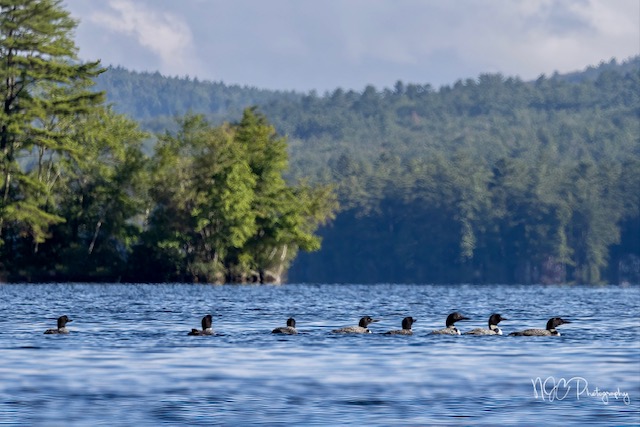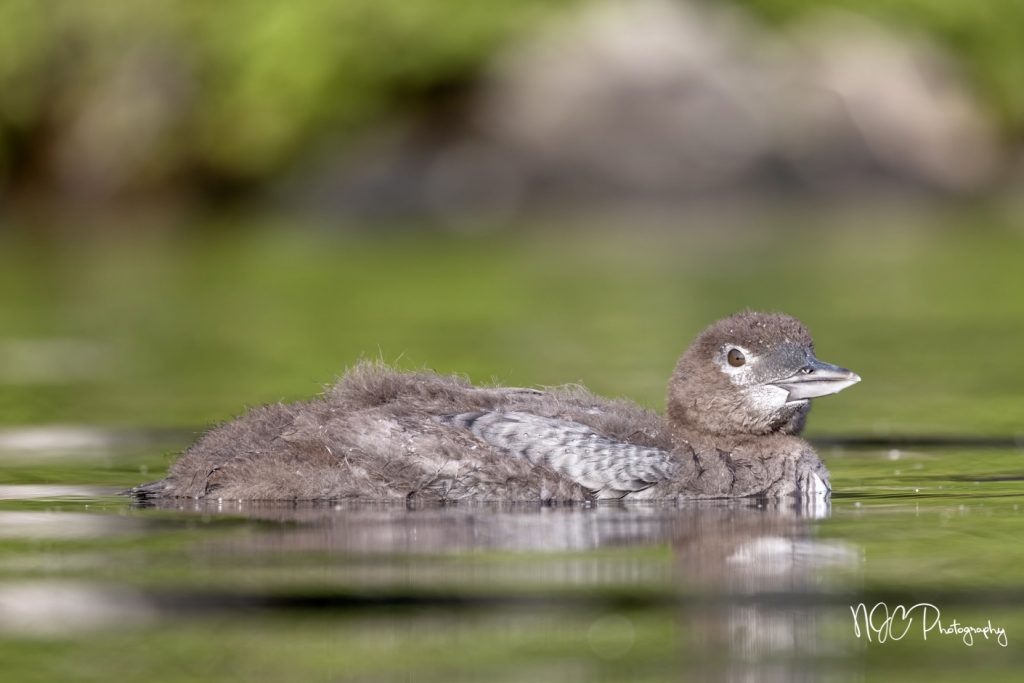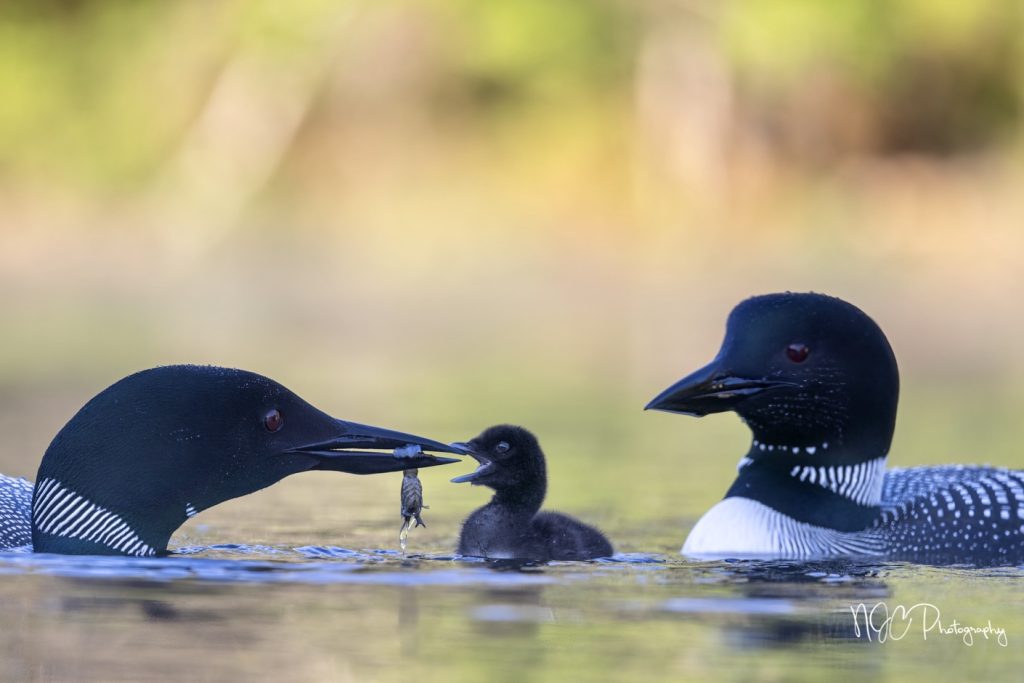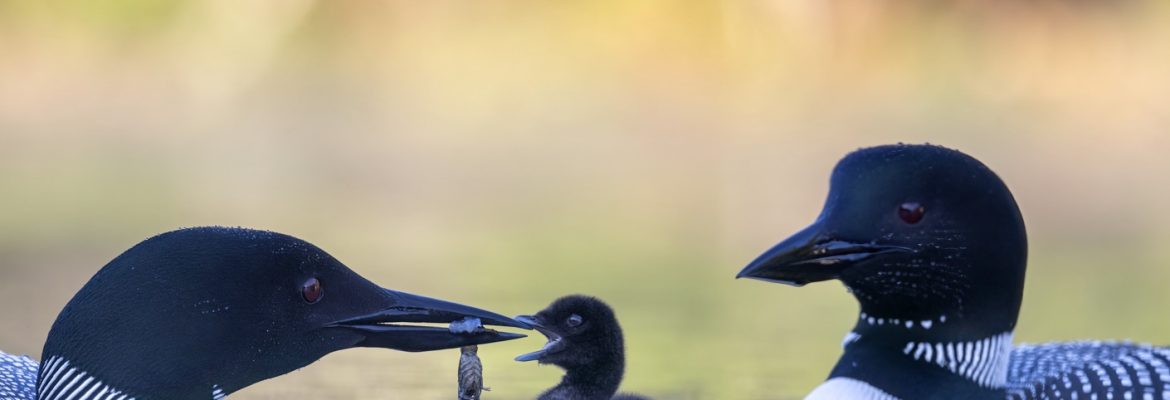by richard niedel – mpa board member
What a privilege it was to watch a newborn loon develop into a juvenile this summer. This maturation was documented daily through the long distance lens of our multi-talented photographer, Nancy Campbell, MPA member and Moose Pond resident. 2022 marked the third year in a row that the loon pair has nested near the narrows, producing 2 eggs this year. Happily, one hatched on July 13. Watching the adults feed the surviving chick and fearlessly protect it was awe-inspiring. Our hearts quickened listening to the haunting warnings of the adults as one of the local bald eagles circled in interest. Stress levels were also up when boaters drove too close or approached the family too quickly. Some jet skiers dangerously threatened the loons as well, riding too close, too fast, and circling the trio. Thankfully, the loon parents were successful in protecting their new offspring.
The historic shape of Moose Pond’s loon population, and this applies to most lakes in our state, is somewhat unknown. Luckily, the Maine Audubon’s Loon Count has been compiling data detailing loon sightings during their one-day loon count since 1983. This invaluable data demonstrates that Moose Pond has supported loon activity for over 39 years! Now, it’s safe to assume loons were on Moose Pond before 1983; there just isn’t supporting documentation. This loon count data does have some limitations. For example, loon chick sightings were infrequently reported in the loon count data sets, and many of the surveys only covered a portion of the lake. Thus, the loon count data can be used to confirm historic loon presence, but can’t necessarily be used to demonstrate loon productivity or loon population shifts for the whole of Moose Pond. Six adults and one chick were observed during Loon Count Day. However, 8 loons were spotted together on the lake on a different day.
The loon count dataset and the Lakes Environmental Association’s (LEA) recent Loon Monitoring Project include observations of both adults and chicks for two out of the last three years. Over these years only 1-2 chicks were observed per year. Moose Pond’s loon population is reported as “likely stable” because eggs are laid and chicks occasionally survive. However, it should be noted that this data can only show us so much. Moose Pond spans approximately 1697 acres, and an average loon’s territory is between 100-150 acres. Thus, it is possible that Moose Pond’s loon population is either under-reported or under-productive. Gathering more data over time will help to clarify this issue.
Another resource is The Loon Restoration Project. This is a collaborative research initiative including Maine Audubon, LEA, Maine Lakes, and the Penobscot Nation. It places artificial nesting platforms in confirmed loon habitats on lakes with declining or under-productive loon populations. The goal is to use the data collected to help determine if artificial nesting platforms increase loon productivity. To accomplish this, LEA is partnering with volunteers who are willing to monitor loon populations during nesting season. This year, an artificial nesting platform was placed in Moose Pond’s southern basin and monitored throughout the season. MPA members, meanwhile, kept tabs on a natural nest. As a result, there is an entire season’s worth of data on two of Moose Pond’s loon pairs for 2022!
Lakeside residents can volunteer
to monitor loon populations…
[and] can support loon
populations by encouraging lake
users to slow down.
Lakeside residents can volunteer to monitor loon populations. On a body of water as large as Moose Pond, the more monitors we have, the more likely we are to locate additional nests and accurately describe the loon population and loon productivity. The north and south basins, in particular, are under-monitored. If anyone within these areas would be interested in checking in on loon populations a few times a month, please contact LEA’s Maggie Welch at maggie@mainelakes.org
Lakeside residents can support loon populations by encouraging lake users to slow down within 200 feet of the shore. This minimizes wake disruption of loon nests. A heavy boat wake can wash over nests and push an egg out. Eggs that fall into the water can’t be recovered by the loons. Similarly, consider limiting firework displays on the water. Loud fireworks scare loons off of their nests. This leaves eggs unattended. If the adult is scared enough to stay away for hours, the egg may get too cold, which decreases the chances of the egg hatching.
Loon populations can also be supported by maintaining a respectful distance. Approaching loons on the nest or chicks in the water is stressful for them. Loons are known to abandon nests if disturbed or threatened. Loon parents will also aggressively protect their chicks if they feel threatened. It’s safest for loons if people and dogs stay back and give them space. Placing signage at public boat launches and providing loon-specific informational brochures to renters can help. On lakes with public access, the biggest obstacle is educating short term visitors, who may not be as invested in loon health as lakeside residents. Leaving well placed, accessible information is a good first step in teaching and mobilizing people toward a better future for the loons.
Kezar Lake is a local success story. After observing poor chick survival rates, they began monitoring their loon population and strategically placed nesting platforms on the lake. Long story short, their chick survival rate is increasing! It takes time and careful monitoring, but bolstering loon populations can absolutely be successful.
MPA wishes to thank Maggie Welch (Staff Researcher LEA) for her significant input to this article, and to Nancy Campbell, MPA member and photographer extraordinaire.
you can learn more about lea at mainelakes.org, and more about the loon restoration project at
maineaudubon.org/projects/loons/loon-restoration-project/




